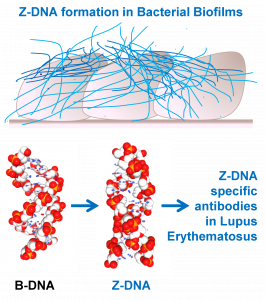An update on the link between bacteria and autoimmune disease
An update on the growing connection between our bacterial microbiome and chronic autoimmune disease
Many roles are now known for Z-DNA in the regulation of gene expression and control of cell death in human cells. These events occur dynamically within cells and involve genomic sequences called flipons that dynamically change conformation. What is unusual about the findings in SLE is that the left-handed Z-DNA is found in outside cells in the external milieux. Even more surprising is that in many cases, the Z-DNA is formed by bacteria as part of the biofilm they use to defend themselves against host responses. The Z-DNA acts as an exoskeleton to protect the bacteria against agents that damage their cell membranes and would otherwise cause them to swell until their membrane ruptures. Biofilms are, for example, one cause of antibiotic resistance. In the context of a bacterial infection, the Z-DNA formed is quite stable. Its persistence can trigger immune responses that lead to the formation of anti-Z_DNA antibodies. Complexes that form between Z-DNA and those antibodies can be trapped in the fine vessels of the skin and kidneys to cause damage to the organs of affected individuals during disease flares. As the disease progresses, the initial immune reaction against Z-DNA can then trigger antibody responses against a range of normal tissues, exacerbating this form of autoimmune disease.
Targeting biofilm formation by bacteria to prevent the Z-DNA formation therefore offers a new opportunity to help patients with SLE.
About InsideOutBio: InsideOutBio is a start-up focused on developing a novel class of proprietary therapeutics to 'light' up tumors for the immune system to kill by reprogramming self/nonself pathways within cancer cells. Dr. Herbert leads discovery at InsideOutBio and contributed to the discovery of flipons. These statements about InsideOutBio comply with Safe-Harbor laws. They are forward-looking and involve known and unknown risks and uncertainties. They are not guarantees of future performance and undue reliance should not be placed on them.
Alan Herbert
InsideOutBio, Inc
+1 617-584-0360
email us here
Visit us on social media:
Twitter
LinkedIn
Legal Disclaimer:
EIN Presswire provides this news content "as is" without warranty of any kind. We do not accept any responsibility or liability for the accuracy, content, images, videos, licenses, completeness, legality, or reliability of the information contained in this article. If you have any complaints or copyright issues related to this article, kindly contact the author above.

